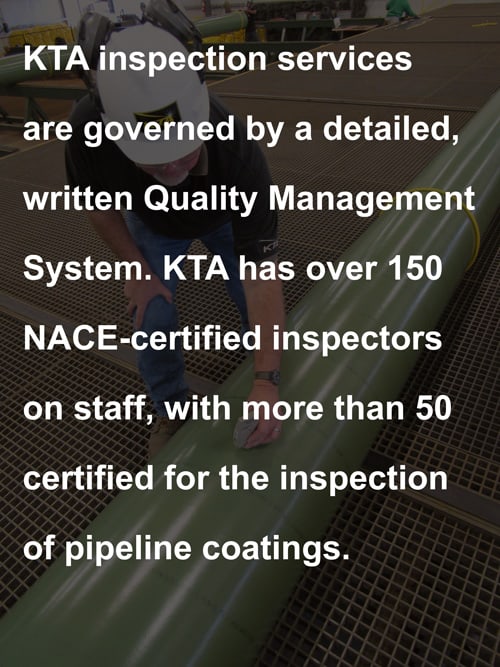 A minor defect in an exterior pipeline coating can have huge consequences. Consider the fire from the Spectra Energy 30” buried pipeline in Salem Township, Westmoreland County, PA on April 30, 2016. Preliminary findings from the investigation indicate that a pinhole or flaw in the tape wrap used to protect the field welded joints may have contributed to advancing corrosion and ultimately perforation. The pipeline was installed in 1981. While some oversight of cleaning and painting (or tape wrapping) may have been performed at that time, training and qualification of personnel involved with cleaning, painting, and inspection of transmission lines was not formalized until the promulgation of the Department of Transportation’s regulations for Pipeline Operator Qualification (OQ). The regulations are found in 49 CFR Part 192 for gas and 49 CFR Part 195 for liquid, and compliance was required starting in 2001.
A minor defect in an exterior pipeline coating can have huge consequences. Consider the fire from the Spectra Energy 30” buried pipeline in Salem Township, Westmoreland County, PA on April 30, 2016. Preliminary findings from the investigation indicate that a pinhole or flaw in the tape wrap used to protect the field welded joints may have contributed to advancing corrosion and ultimately perforation. The pipeline was installed in 1981. While some oversight of cleaning and painting (or tape wrapping) may have been performed at that time, training and qualification of personnel involved with cleaning, painting, and inspection of transmission lines was not formalized until the promulgation of the Department of Transportation’s regulations for Pipeline Operator Qualification (OQ). The regulations are found in 49 CFR Part 192 for gas and 49 CFR Part 195 for liquid, and compliance was required starting in 2001.
Today, coating materials and tape wraps are thoroughly tested by the manufacturers prior to release, often supported by additional 3rd party laboratory testing. Controls over the application of protective exterior coatings on transmission lines in both the shop and field, as well as the protection of field joints is accomplished by trained personnel. Events like Salem Township are preventable if the correct materials are selected and they are installed properly.
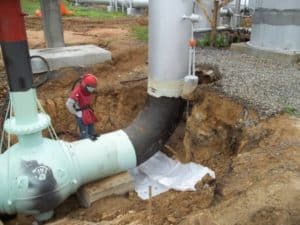
Interestingly, the installation of coatings on gathering lines is not regulated, but the use of trained and certified installers and inspectors would be a wise investment there as well.
This article provides a brief overview of materials and installation practices for corrosion protection materials used on the exterior surfaces of buried pipelines, Fusion bonded epoxy (FBE) is a widely specified coating for the protection of pipeline exteriors. It is applied in specialty application facilities. While some repairs are performed following the initial application at the shop to correct holidays or voids in the coating, most of the repairs are performed following installation of the pipe components in the field. This can include repairs due to handling damage, girth weld connection areas, as well as painting of installed components such as valves or fittings (Figure 1) that may not have been provided with an approved corrosion resistant coating.
There are a variety of different methods to accomplish incidental repairs and repair of larger areas of damage and weld connection zones. Tapes, melt patch compounds, shrink sleeves, two-component epoxies, and some mastic coatings are commercially available for this purpose. The choice of the method or material can be affected by the size of the area, the location, time of year, whether the coated surface will be buried or exposed to atmospheric conditions, and other factors.
Also critical to installation of these repair materials is verifying that all exposed substrate is addressed and that the installation is void free. But before the applicators and inspectors get to the point of final inspections, many steps should have happened in accordance with the work specifications and material supplier installation instructions. Some materials require heating of the metallic substrate to a designated temperature, which can be problematic in cold environments. In many cases abrasive blast cleaning is required to prepare the surface, which can be complicated by rough or steep terrains, access to the work, proximity to residential communities, and a variety of other constraints.
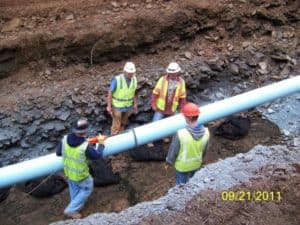
For minor or small repairs such as a small nick in the coating, a hot melt epoxy stick is often used to seal the affected area. Commonly the area is roughened by sanding with a medium grit sandpaper and wiped clean of debris. The area to be coated is generally preheated using a hand-held butane torch. Care must be taken to not burn or char the existing FBE coating, although slight discoloration is common. The stick is then melted repeatedly until a smooth void-free coating is applied to about the same thickness as the existing coating. The coating should be visually inspected to verify complete coverage followed by holiday testing (Figure 2) to verify that the coating is in fact void-free. This method of repair is generally limited to areas less than 1/4″ in size.
The most common field repair method is application of a two component epoxy coating that is formulated to be compatible with the shop applied FBE coating. Generally, this method requires pre-cleaning the area with detergents or solvents to remove construction contaminants, followed by abrasive blast cleaning to a NACE No. 2/SSPC-SP10 Near-White or in some cases power tool cleaning to SSPC-SP11, Power Tool Cleaning to Bare Metal. Overlap areas onto the existing FBE coating must also be roughened, and may be specified to be solvent cleaned just prior to coating application. The coating material can then be brushed, rolled, or spray applied to the specified thickness. Critical to this process is maintaining proper ambient conditions during application and drying. In cold temperatures this is typically addressed by enclosing the work area and providing indirect fired heat to ensure ensure the air and surface temperatures are within a specified range, the surface temperature is above the dew point, and that the temperatures are maintained during the curing of the coating. In recent years, cold-temperature and moisture tolerant coating materials have been developed to mitigate some of these coating installation challenges. Also important is verifying that the coating potlife is not exceeded, as many of these materials have a relatively short working time. Many applicators therefore mix smaller amounts so as not to waste coating materials.
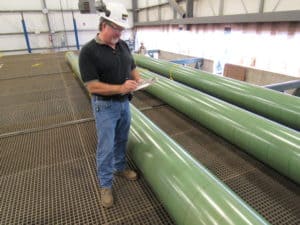
Many of these same materials are used to apply a corrosion resistant coating over an OEM coating material supplied on components such as valves. Prior to application it must be verified that the epoxy coating is compatible with the manufacturer’s installed coating. It should first be established that the manufacturer’s coating is adherent to the metal substrate by performing knife adhesion testing in accordance with ASTM D3359, “Standard Test Methods for Measuring Adhesion by Tape Test,” or ASTM D6677, “Standard Test Method for Evaluating Adhesion by Knife.” Some specifications require that the coating be assessed by performing solvent resistance testing in accordance with ASTM D5402, “Standard Practice for Assessing the Solvent Resistance of Organic Coatings Using Solvent Rubs.” This test can provide insight into whether the field applied epoxy might soften the existing coating.
Another option, and one many coating manufacturers endorse, is to apply a small test patch of the epoxy to the existing OEM coating. Typically, the specified surface preparation protocol is followed, generally including surface roughening by hand or power tools, surface cleaning of debris, and sometimes solvent cleaning followed by a brush application of the coating. Following a specified cure time for the epoxy, adhesion is assessed by performing a knife test. Frequently, a topcoat is applied for UV protection and color coding of specific components. Without the topcoat, the epoxy will chalk when exposed to sunlight.
Another option for girth weld locations is installation of a heat shrinkable tubular sleeve. These sleeves typically consist of a polyolefin backing coated with a heat sensitive adhesive that bonds the sleeve tightly to the substrate. The installation of the material may require initial training, but within a short period of time applicators acquire the skills needed to properly install the sleeve. Some manufacturers also supplement the material with tools to aid in the ease of installation.
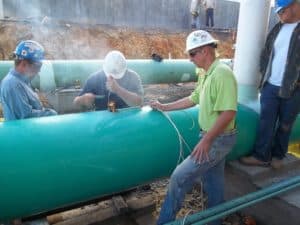
Cold applied tapes are another option for pipe joints, fittings, and specialty piping components that are irregular in shape. These materials have a wide range of composition and adhesive characteristics, and are corrosion resistant in many environments and temperatures. Like the sleeves, applicators usually acquire the needed installation skills in a short period of time.
Key to the proper installation and performance of any material is the training of the applicators and inspectors tasked with completing the work. The training can be administered by knowledgeable contractor personnel, the material supplier, a consultant, a training provider, or the owner. The training should consist of written information on how and why certain surface preparation methods are achieved, information on the handling and mixing of materials, details on application methods and the verification methods necessary to confirm that the quality of the installation will result in long lasting corrosion protection. Applicator training should include hands-on training and demonstration of all of the means and methods necessary to accomplish the work, along with demonstration of the applicator’s ability and understanding of the materials and installation instructions.
The inspector should receive the same training, although proficiency in the application may not be expected. The inspector and applicator should not only understand what constitutes acceptable workmanship, but also what occurrences can lead to deficiencies, how to prevent them from happening during installation, and how to properly repair them when they do occur. After all, a minor defect can have huge consequences!
About the Author:
 Bruce is the Vice President of the Coatings Groups for KTA where he has been employed for over 30 years. He is responsible for various design and construction-phase coating consulting and inspection services provided to diverse clients nationwide and manages a large staff of coatings professionals including over 100 inspectors deployed across the U.S and abroad. Bruce is a NACE Certified Coatings Inspector Level 3 (Peer Review), an SSPC Certified Protective Coatings Specialist, a Nuclear Safety Related Coating Specialist, an ANSI N45.2.6 (ASTM D 4537) and a certified Insulation Energy Appraiser by the National Institute for the Uniform Licensing of Power Engineers and the National Insulation Association. He holds a B.S. in Business Administration from the Pennsylvania State University.
Bruce is the Vice President of the Coatings Groups for KTA where he has been employed for over 30 years. He is responsible for various design and construction-phase coating consulting and inspection services provided to diverse clients nationwide and manages a large staff of coatings professionals including over 100 inspectors deployed across the U.S and abroad. Bruce is a NACE Certified Coatings Inspector Level 3 (Peer Review), an SSPC Certified Protective Coatings Specialist, a Nuclear Safety Related Coating Specialist, an ANSI N45.2.6 (ASTM D 4537) and a certified Insulation Energy Appraiser by the National Institute for the Uniform Licensing of Power Engineers and the National Insulation Association. He holds a B.S. in Business Administration from the Pennsylvania State University.
if you liked this article, you might also enjoy…
https://ktauniversity.com/meeting-demands-of-gas-exploration-the-evolution-of-pipeline-coatings/
https://ktauniversity.com/the-shop-coating-pipeline-that-cracked/
https://ktauniversity.com/maintenance-painting-practices-for-offshore-oil-gas-structures-part-one/


perfect text
well done Bruce, this article relates to epxperienced man.
Thank you.good information
Great Article
Thanks for sharing this informative blog.
We’re glad you found it helpful! Thank you for the comment.